Supporting evaluation components of the Lake Huron Technical Committee’s Cisco reintroduction study for FY24
Contributing Authors
Jose Bonilla-Gomez (USFWS, jose_bonillagomez@fws.gov), Kevin McDonnell (UWFWS), Amanda Ackiss (USGS), Timothy O'Brien (USGS), Cory Brant (USGS), Dave Fielder (MIDNR), Todd Hayden (USGS), Adam Kowalski (USFWS), Andrew Honsey (USGS), Darryl Hondorp (USGS), Jason Smith (Sault Ste Marie Tribe of Chippewa Indians)
Project Description
Cisco (Coregonus artedi) are functionally absent from the western main basin of Lake Huron and as such restoring Cisco “to a significant level” (DesJardine 1995) remains an unmet objective for Lake Huron management agencies (Riley and Ebener 2020). In 2007 the Lake Huron Technical Committee (LHTC) developed a recovery guide for Cisco in Lake Huron for the Lake Huron Committee (LHC) of the Great Lakes Fisheries Commission (LHTC 2007; Liskauskas et al. 2007). The LHC formally adopted a proposal in 2015 to evaluate if cultured Cisco would be able to reestablish a self-sustaining population in Saginaw Bay, Lake Huron. Saginaw Bay was historically important for Cisco spawning and once supported the largest fishery in Lake Huron (Berst and Spangler 1973; Baldwin et al. 2009). To evaluate restoration strategies in this area, the LHC requested Region 3 National Fish Hatchery System produce and stock 1 million (± 20%) Cisco fingerlings annually for ten years into Saginaw Bay.
Fingerling age-0 Cisco have been stocked in Saginaw Bay annually, beginning in 2018, and spring age-0 and fall age-0 fingerlings will be stocked annually through 2027. Early life-history monitoring, assessment of post-stocking survival, and spawning monitoring have all been identified as key elements of the stocking program evaluation (LHTC 2023). Post stocking evaluations commenced in 2019 and have continued through 2022. During the 2022 fall spawning gillnet survey we found 49 mature ripe adults (46 hatchery origin and 3 wild). All these fish were collected near the onshore stocking location. The oxytetracycline (OTC) marks analysis showed 89.8% of the specimens were from the spring release, 4.1% were from the fall release. These initial results suggest cultured Cisco can survive and spawn in Saginaw Bay, however it is yet to be determined if they can produce viable recruits. Additional monitoring of larval production, juvenile survival and adult spawning remains critical to effectively evaluate how successful the restoration efforts have been and to provide insights that may improve future restoration strategies.
We are requesting funds to build off our previous work and to continue the Cisco monitoring and evaluation in Saginaw Bay for FY24. It currently remains unknown to what extent now hatchery Cisco will show fidelity to their original stocking site during spawning, if predation is occurring on newly stocked Cisco, how well juvenile hatchery Cisco are surviving and if any successful Cisco reproduction is occurring in Saginaw Bay. We therefore propose to monitor coregonine egg deposition in Saginaw Bay to describe spatial temporal trends in Cisco spawning activity during spawning season. Additional funds will allow us to investigate these questions directly in FY24. Alpena Fish and Wildlife Conservation Office will continue to act as the lead agency for these elements with support from USGS, Michigan DNR, and Sault Ste. Marie Tribe.
